Shwedagon and the Golden Rock
Friday 17 December - Sunday 19 December
 Rangoon
is an interesting but
tired looking city. It has only
been Myanmar’s capital for a little over 100 years; in fact it became the
capital in 1885, when the British completed the conquest of Upper Burma and
Mandalay’s brief period as the centre of the last Burmese kingdom ended.
Superficially Rangoon is a pleasant, open city with trees lining
the boulevards and green open spaces; but it is also a run down and
neglected place with a somewhat seedy air of dirt and decay.
Rangoon
is an interesting but
tired looking city. It has only
been Myanmar’s capital for a little over 100 years; in fact it became the
capital in 1885, when the British completed the conquest of Upper Burma and
Mandalay’s brief period as the centre of the last Burmese kingdom ended.
Superficially Rangoon is a pleasant, open city with trees lining
the boulevards and green open spaces; but it is also a run down and
neglected place with a somewhat seedy air of dirt and decay.
Rangoon's streets are lined with stalls of all different kinds selling
everything from food, clothing, cheap local cigars and books.
Bookstalls seemed to appear
everywhere, from the main boulevard to side alleyways and even on the pavements
at street corners; a bizarre, random collection of books and magazines, many old
(judging by the proliferation of Woman’s Weekly and equally outdated 1950/60s
publications, probably leftovers from the last of the British inhabitants), some obviously castaways from earlier
travellers and others perhaps illicit copies that had found their way into the
country and not been confiscated. We were surprised at this apparent book-craze,
but given the strict restrictions on published material anywhere within the
country, it is perhaps not surprising that those who can afford it will buy or
recycle anything they can read and gain insights from, particularly concerning their
own country. After out tenth
sighting of George Orwell’s Burmese Days (a copy of which we had
brought with us to read), we realised upon closer inspection that all the
recent or Burma-specific books (doubtless those in greatest demand) were in fact
photocopies. Entire books,
photocopied with a cover that at first glance certainly looked
authentic. Perhaps this was not motivated by
profit so much as necessity.
Hidden away down one alleyway,
we found a small, cluttered bookshop with a similarly bizarre collection of
books decorating its shelves, and on talking with the owner managed to get a
small insight into this strange but intriguing business. Original copies were scarce but given the demand for written
material, the idea of photocopying originals to allow for greater circulation
had become widespread. The original
versions were treated like prize possessions and deemed to be as valuable as
gold dust and certainly not for sale. But
even this friendly book-loving Burmese man was cagey in his answers and not as
forthcoming in his responses as we might have liked.
His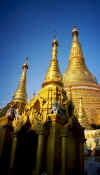 parting plea was for any books we may be able to bring with us should
we visit the country again; sending them to him by post would be futile as
many had been sent previously and yet, as if they had entered the Bermuda
Triangle, disappeared without a trace.
parting plea was for any books we may be able to bring with us should
we visit the country again; sending them to him by post would be futile as
many had been sent previously and yet, as if they had entered the Bermuda
Triangle, disappeared without a trace.
The most
impressive sight the city has to offer is that of the Shwedagon Pagoda, a huge
and sacred Buddhist temple that dominates the entire city from its hilltop
location. At almost 100 metres (300
feet) high, the temple can be seen for miles, including from the plane as you
come into land at Rangoon airport. The
current stupa dates from the 18th century, but the site itself is much
older. The current spire is now
encrusted with more than 5,000 diamonds and over 2,000 other precious and
semi-precious stones.
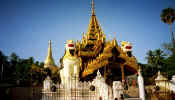 You enter
Shwedagon up a huge
marble staircase lined on both sides with shops selling everything from Buddha
images, gold leaf and lacquerware to monk’s paraphernalia and more.
The staircase crosses the old fortifications (a now dried up moat) and as
you reach the top,
You enter
Shwedagon up a huge
marble staircase lined on both sides with shops selling everything from Buddha
images, gold leaf and lacquerware to monk’s paraphernalia and more.
The staircase crosses the old fortifications (a now dried up moat) and as
you reach the top,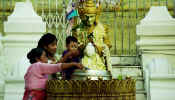 you pass through a glittering
shrine hall.
There is a pell-mell of
people from all walks of life who have come to worship together with monks and,
of course, the occasional tourist. At
the base of the stupa are eight planetary posts (shrines) that represent the
eight days of the week (in Burmese astrology, in case you'd didn't know, the week has eight days, Wednesday
being split into morning and evening). Those
born on a Sunday, would take flowers, light a candle and pour water over the
image in the Sunday corner, while those born on a Tuesday would do the same
in the Tuesday corner.
you pass through a glittering
shrine hall.
There is a pell-mell of
people from all walks of life who have come to worship together with monks and,
of course, the occasional tourist. At
the base of the stupa are eight planetary posts (shrines) that represent the
eight days of the week (in Burmese astrology, in case you'd didn't know, the week has eight days, Wednesday
being split into morning and evening). Those
born on a Sunday, would take flowers, light a candle and pour water over the
image in the Sunday corner, while those born on a Tuesday would do the same
in the Tuesday corner.
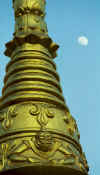
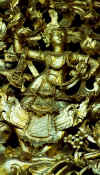 Some of the pavilions
surrounding the Pagoda contain beautiful wood carvings, others are shrine halls
containing statues at the base of which people can leave their offerings.
As dusk fell, we were surrounded by the warm red glow of a setting sun
and impressed by the splendor of this spectacular place, filled with
pilgrims and people lost in prayer fulfilling acts of devotion at the different
stations of worship. It was a wonderful experience… not to mention a great
photo opportunity.
Some of the pavilions
surrounding the Pagoda contain beautiful wood carvings, others are shrine halls
containing statues at the base of which people can leave their offerings.
As dusk fell, we were surrounded by the warm red glow of a setting sun
and impressed by the splendor of this spectacular place, filled with
pilgrims and people lost in prayer fulfilling acts of devotion at the different
stations of worship. It was a wonderful experience… not to mention a great
photo opportunity.
Shwedagon is a famous temple,
one of the most renowned in the Buddhist world. And as a work of art, this
seemed to us well-deserved. But as a place of devotion, the Golden Rock is
incomparably more impressive. Our first sighting of the Golden
Rock (otherwise known as the Kyaiktiyo Pagoda)
was in Bangkok. Looking for
distractions during the wait for our visas at the Burmese embassy, we
happened upon an advertisement flyer for the Golden Rock Hotel and, within
seconds, Pippa had determined that if we saw absolutely nothing else in Burma,
we were going to see this.
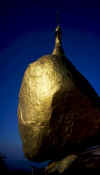 Situated a
few hours drive south east of Rangoon, this small pagoda is one of the most
sacred sites in Burma and has, in the past, been off limits to tourists (even
more reason as far as Pippa could see to ensure we saw it this time around lest
it be closed off again). The stupa is only
about 8 metres (25 feet) high, but what makes it such an incredible sight is that it sits
atop the Golden Rock, a massive gold-leafed boulder that balances
precariously on the very edge of a cliff at the summit of Mount Kyaiktiyo.
According to legend, it is held in place by a strand of Buddha’s hair and
throughout the year, thousands upon thousands of devout Buddhists make their
pilgrimage to this holy site. Their fervor is what makes this not just a
sight but an experience not to be missed.
Situated a
few hours drive south east of Rangoon, this small pagoda is one of the most
sacred sites in Burma and has, in the past, been off limits to tourists (even
more reason as far as Pippa could see to ensure we saw it this time around lest
it be closed off again). The stupa is only
about 8 metres (25 feet) high, but what makes it such an incredible sight is that it sits
atop the Golden Rock, a massive gold-leafed boulder that balances
precariously on the very edge of a cliff at the summit of Mount Kyaiktiyo.
According to legend, it is held in place by a strand of Buddha’s hair and
throughout the year, thousands upon thousands of devout Buddhists make their
pilgrimage to this holy site. Their fervor is what makes this not just a
sight but an experience not to be missed.
The small town at the base of the mountain
was teeming with people of all ages.
It seemed to consist of one massive bus depot with trucks and other
vehicles over-laden with both bodies and luggage arriving and departing in a
continuous stream. We watched this
huge hubbub through a cloud of dust that never seemed to settle before the next
set of wheels ploughed its way through the dirt.
People stepped off the buses in which they had arrived and transferred
into what looked like cattle trucks for the 35-minute drive up the mountain to the end of the road (and,
happily in our case, the hotel in which we were
staying). After acquiring permits
for the ascent, our driver set out up the winding road that looked almost
vertical in parts. We wondered if the car would make it to the top given how
hard the engine labored on some of the slopes.
Twice we were asked to get out and walk as the car, in first gear, came
to a standstill and began a slow, steady roll backwards.
The lot at the end of the road
was bustling with people, some
resting or stocking up on refreshments, others piling their bundles of
provisions and clothing onto their backs and setting out on foot to begin the
remaining ascent. From here, it was
a steep 45-minute walk to the summit but for the faint-hearted, four-men teams
carrying bamboo sedan-type chairs could be hired, for a price.
It became apparent that many of the locals could obviously not afford
such luxuries, as we passed several old men and woman who had stopped at
the roadside, leaning on their sticks to catch their breath.
However much in pain they appeared to be at times, gasping for air or
even being sick as their bodies labored under the intense physical exertion, it
seemed as if nothing would stop these people making it to the top after they had
come such a long way. Even for us,
the climb was long and arduous, and although we set out with plenty of time to
spare, we realised sunset was fast approaching and we still had a long way to
climb.
About three-quarters of the way
up, we were rewarded with our first glimpse of the pagoda, still looking a long
way off in the distance across on the next ridge; the pagoda looked tiny perched up on
its huge boulder.
The last part of the climb was along an irregularly bricked, stepped path
with stalls selling weird and wonderful curios lined along each side, those on
the right having been carved into the hillside.
Some resembled Chinese market places with traditional medicines, skulls,
bone parts, massive black beetles, snakes and other insects of varying shapes
and sizes (all dead, thankfully), leopard skins, bear skins and stuffed animals
of all kinds, all for sale. Presumably
many of the latter were considered to contain medicinal properties, but we
didn’t stop too long at any one stall to find out; as soon as you were spotted
taking an interest, the stall keeper and his family would be dangling objects in
front of your face as if they expected you to be more impressed by the quality of
their wares upon more detailed inspection.
And so, tired and breathless, we
finally reached ... a police
checkpoint! And after the necessary arrangements, we made our
way to a huge marble staircase
leading up to the platform that looks over the Golden Rock. Hundreds of pairs of shoes were scattered across the ground
but, cautious as always, once removing ours, we attached them to our backpack
and carried them with us, opting to leave our socks on after a closer inspection
of the cold and filthy pavement ahead of us.
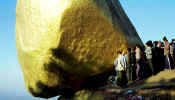 It was a strange and curious sight at the square on the summit. The
pagoda sits slightly below the square to the left, but there is activity all
around and in a strange way, the whole place had almost a fairground feel to it.
There was a large carousel in the centre of the square with shops and
restaurants built up around the edges. Some
of the shops sold a bizarre collection of toys made from bamboo and other kinds
of wood ranging from fairly innocuous looking flutes and cameras to not-so-heavenly looking rifles and sabers. There
was a constant babble of noise accompanying this spiritually charged atmosphere,
overridden only by frequent prayers booming over the loud-speaker system.
Many
It was a strange and curious sight at the square on the summit. The
pagoda sits slightly below the square to the left, but there is activity all
around and in a strange way, the whole place had almost a fairground feel to it.
There was a large carousel in the centre of the square with shops and
restaurants built up around the edges. Some
of the shops sold a bizarre collection of toys made from bamboo and other kinds
of wood ranging from fairly innocuous looking flutes and cameras to not-so-heavenly looking rifles and sabers. There
was a constant babble of noise accompanying this spiritually charged atmosphere,
overridden only by frequent prayers booming over the loud-speaker system.
Many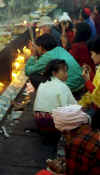 people had laid their mats on the ground and were either praying or
sleeping (we realized on our return at sunrise the next morning that some people
actually spent the night here) and, every now and again, we would spot a
solitary monk sitting in meditation seemingly oblivious to the mayhem around
him.
people had laid their mats on the ground and were either praying or
sleeping (we realized on our return at sunrise the next morning that some people
actually spent the night here) and, every now and again, we would spot a
solitary monk sitting in meditation seemingly oblivious to the mayhem around
him.
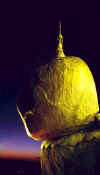 The pagoda itself
was accessible,
but only to men. A queue formed on
the bridge leading over to the golden rock and with gold leaf in hand, men come
to kneel at the boulder, pray and apply their gold leaf. The women watched from their own platform across to the side
and prayed as their husbands or sons apply leaf on their behalf.
It seemed as if the more daring a place you find to apply your gold leaf,
the more likely your prayers would be answered, and we saw some alarming displays of
bravado as men would crawl right to the edge of the precipice to stick their gold on the
underside of the overhang (there were, of course, no barriers or signs warning
of the inherent danger of being so close to the edge of a sheer drop to the
valley below). In the
meantime, there were several collections of people meditating, praying and
observing, offering gifts of flowers and incense at the various shrines and
lighting handfuls of
The pagoda itself
was accessible,
but only to men. A queue formed on
the bridge leading over to the golden rock and with gold leaf in hand, men come
to kneel at the boulder, pray and apply their gold leaf. The women watched from their own platform across to the side
and prayed as their husbands or sons apply leaf on their behalf.
It seemed as if the more daring a place you find to apply your gold leaf,
the more likely your prayers would be answered, and we saw some alarming displays of
bravado as men would crawl right to the edge of the precipice to stick their gold on the
underside of the overhang (there were, of course, no barriers or signs warning
of the inherent danger of being so close to the edge of a sheer drop to the
valley below). In the
meantime, there were several collections of people meditating, praying and
observing, offering gifts of flowers and incense at the various shrines and
lighting handfuls of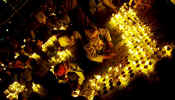 candles that they had either brought with them or
bought at
the numerous stalls on the way up the mountain.
As the sun set, the Golden Rock burned in a reddish glow and as night
fell, more and more candles lit up the darkness.
People kept streaming in to carve out a place in front of the shrines
overlooking the pagoda, and as we left to head back down to our hotel, we were in
no doubt that this was a 24 hour vigil.
candles that they had either brought with them or
bought at
the numerous stalls on the way up the mountain.
As the sun set, the Golden Rock burned in a reddish glow and as night
fell, more and more candles lit up the darkness.
People kept streaming in to carve out a place in front of the shrines
overlooking the pagoda, and as we left to head back down to our hotel, we were in
no doubt that this was a 24 hour vigil.
At sunrise the next morning,
after another breathless ascent, the air was as charged as it had been the previous
evening and we saw much of the same ardent religious fervor, but instead of
bunches of flowers, incense and candles, trays of food were being offered ...
and recycled!. People would pay for
the food trays at makeshift stalls that had been set up overnight, and placed
these on the shrines, where they rested until people swept them away and took them back to the
food stalls to be resold.
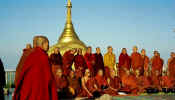 As with sunset, sunrise created
a mysterious aura around the golden rock and its surrounding platform.
It was a moving experience by any standards, watching the various
different rituals of worship unfold around this important relic, regardless of
your religion. Both visits had
given us an insight to how important this pagoda is to Buddhists, particularly
in Burma, and both had proved to be magical and awe-inspiring in their own
way. That morning, as we departed
to once again make our descent, we saw many more monks meditating in the shadow
of the pagoda and then lining up to receive alms from the pilgrims who had come
to offer their prayers.
As with sunset, sunrise created
a mysterious aura around the golden rock and its surrounding platform.
It was a moving experience by any standards, watching the various
different rituals of worship unfold around this important relic, regardless of
your religion. Both visits had
given us an insight to how important this pagoda is to Buddhists, particularly
in Burma, and both had proved to be magical and awe-inspiring in their own
way. That morning, as we departed
to once again make our descent, we saw many more monks meditating in the shadow
of the pagoda and then lining up to receive alms from the pilgrims who had come
to offer their prayers.
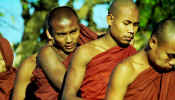 And so we concluded our
brief tour of Burma. As we
made our way back to Rangoon, we reflected on the two weeks we had to explore
this amazing country, and were so glad we had made the decision to visit.
While we had not had a chance to squeeze in other sights such as Inle
Lake, where they have perfected a peculiar form of boat-rowing, or southern
parts of the country that are still off limits, we did manage to get first hand
accounts and photos of places we had missed from Iain that have
convinced us this will not be our last trip to this remarkable country. But for now, our next stop was
to be India, and so once again we headed back to Bangkok where we were to have a
few hours stopover before flying on to Delhi via Bangladesh.
And so we concluded our
brief tour of Burma. As we
made our way back to Rangoon, we reflected on the two weeks we had to explore
this amazing country, and were so glad we had made the decision to visit.
While we had not had a chance to squeeze in other sights such as Inle
Lake, where they have perfected a peculiar form of boat-rowing, or southern
parts of the country that are still off limits, we did manage to get first hand
accounts and photos of places we had missed from Iain that have
convinced us this will not be our last trip to this remarkable country. But for now, our next stop was
to be India, and so once again we headed back to Bangkok where we were to have a
few hours stopover before flying on to Delhi via Bangladesh.